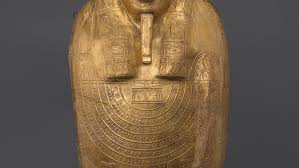
This sculpture is world-renowned as the Turin masterpiece portrait of Egypt’s longest-reigning and most famous pharaoh. King Ramesses II appears in the Blue Crown or war helmet, grasping the head-sceptre.
Breaking with traditional royal portraits, the great general wears a long full robe that is asymmetrically draped to create an enormous bell sleeve and his feet are shod in sandals. Had the Amarna Period not intervened, we would expect the king to be barefoot and wearing a kilt that allowed free movement, as on the battlefield.
It is also the Amarna artistic innovation that made it possible for the face to be more realistically modelled, with real sockets and lids for the eyes. The nose is extremely large, the mouth is proportionally small and the chin is even recessive, all which are unusual until this point.
A concession to tradition is the incision of the eyebrows and cosmetic stripes. The nine bows, representing the enemy foreign tribes, are symbolically incised under the king’s feet and two prisoners, an Asiatic and a Nubian are also depicted on the base, underscoring the king’s absolute supremacy over Egypt and its possessions.
Left and right of the king’s legs, on a smaller scale and according to their relative importance, are the figures of Queen Nefertari, identified in the inscription as beloved by the Theban goddess Mut, and Ramesses’ son Amun-her-Shepshed, identified as the right-hand plume bearer and beloved son.
The New Kingdom, 19th Dynasty, reign of Ramesses II, ca. 1279-1213 BC. From Karnak. Now in the Egyptian Museum of Turin.



















